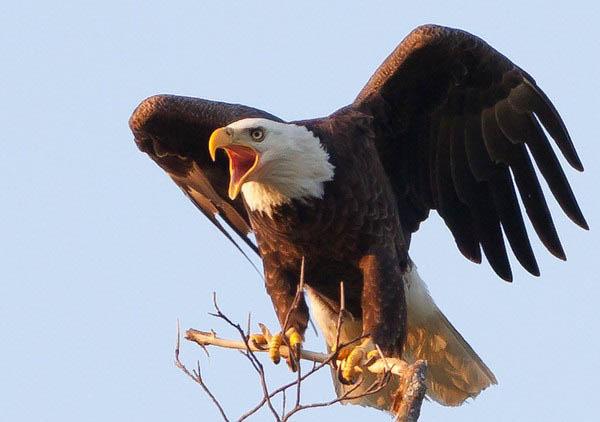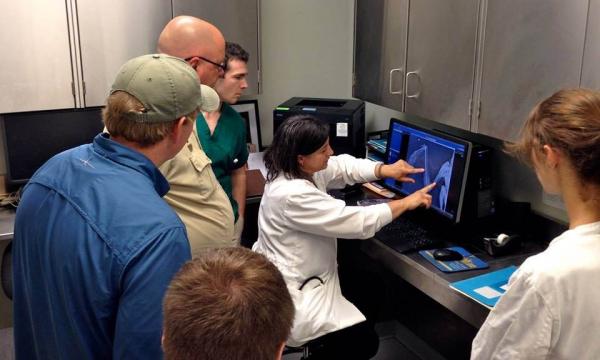
Talk about effective visual aids.
For the past six years, people around the world have had a unique opportunity to learn more about the secret lives of bald eagles without ever leaving their homes or offices, thanks to the folks at a state park golf course in eastern Tennessee. Followers of the Harrison Bay Eagle Cam now have a chance to visit the property to learn firsthand about the nesting habits of bald eagles.
The second-annual Harrison Bay Eagle Cam Meet and Greet and Nest Tour is scheduled for May 13-14 at Harrison Bay State Park just outside Chattanooga.
The event is open to the public, and will include displays, videos and opportunities to see a live bald eagle up close and personal, courtesy of Dave Haggard, a ranger and state naturalist at Reelfoot Lake State Park in Hornbeak, Tennessee. Reelfoot houses several rescue raptors, including hawks, owls and an eagle that cannot be returned to the wild.
The Harrison Bay Eagle Cam project took flight late in 2011 after a pair of bald eagles began building a nest in the top of a tall pine along the Bear Trace golf course inside the park. The project initiated by the Friends of Harrison Bay State Park, a community group that does projects and fundraising for Harrison Bay State Park. Park staff also reached out to the USGA, our superintendent chapters, Toro Co., Smith Turf and Irrigation, and others.
Since then, five pairs of eaglets have been hatched at Harrison Bay and locals as well as online visitors from around the world have learned more about the good stories golf has to tell.
"The Harrison Bay Eagle Cam gives people, golfers and nongolfers alike, an up close look into the nesting habits and practices of a pair of American bald eagles," said Bear Trace superintendent Paul Carter, CGCS. "It also demonstrates that if managed properly golf courses can be an environmental sanctuary where wildlife can thrive and raise their families."
This year's eaglets, HB9 and HB10, hatched March 5 and March 6, respectively.They are the ninth and 10th eaglets fledged at Harrison Bay since 2011. A pair of eaglets hatched in 2012 did not survive.
 Thanks to the fundraising efforts of the Friends of Harrison Bay, the park has been able to upgrade video equipment each year, and Elliot and Eloise, who were named by Carter's daughter Hannah, have been broadcasting in high definition since 2014. The program's popularity has grown each year, with hundreds of viewers checking in from all around the globe to watch from the time eggs are laid to the eaglets hatching and eventually leaving the nest - usually five to six months after hatching, according to the U.S. Fish and Wildlife Service. It's not uncommon to watch online as one of the adults shreds a fish or a blackbird to feed to the young.
Thanks to the fundraising efforts of the Friends of Harrison Bay, the park has been able to upgrade video equipment each year, and Elliot and Eloise, who were named by Carter's daughter Hannah, have been broadcasting in high definition since 2014. The program's popularity has grown each year, with hundreds of viewers checking in from all around the globe to watch from the time eggs are laid to the eaglets hatching and eventually leaving the nest - usually five to six months after hatching, according to the U.S. Fish and Wildlife Service. It's not uncommon to watch online as one of the adults shreds a fish or a blackbird to feed to the young. The meet and greet will begin May 13 with a dinner and other activities, including a history of the eagle cam project and a chance to see Haggard's rescue eagle. Officials with the USGA and the American Eagle Foundation also have been invited to participate. Donations will be accepted and all proceeds benefit the Harrison Bay Eagle Cam project.
The following day's events begin at 7 a.m. with a site visit to a spot nearby the nest and a chance to view the eagles through long-range spotting scopes.
Carter, who has been an instrumental part of the program since its inception says telling the two birds apart - bald eagle pairs stay with the same mate for life - is easy after a while.
"Eloise is about 20 to 25 percent larger than Elliott, which is common in the raptor species," he said. "Sure ways to tell them apart is to look at the orbital ridge, or eyebrow area. Eloise has a very distinct stern look about her at all times. Her beak is darker yellow and shows signs of age and use. If you look at her legs you will see white feathers on them. If watching at night, it is 99.99 percent certain that she is on the nest, as that is her nature."

